Sudoku
Killer Sudoku Pro / All Signs
May 1st
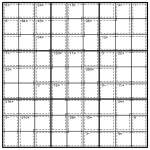
Killer Sudoku All Signs puzzle
Here’s a Killer Sudoku with “all the signs”, or Killer Sudoku Pro if you prefer. If you’ve got any ideas for a better name let me know! ![]()
As in a regular Killer puzzle, you can’t repeat a digit within the solution to any cage. Unlike in a regular Killer, all non-single cages specify the operation that is applied to produce the result given. If the operation is + or x then just add or multiply all the digits to give that total. For subtraction and division you must start with the largest number in the region and subtract or divide the other numbers from that to give the stated result (this is what you’d do intuitively, I think, but since these operations aren’t commutative it’s necessary to state this!) Other than that, regular Sudoku rules apply: place 1 to 9 into each row, column and bold-lined 3×3 box.
The logic is once again simple, as a first example of this puzzle type, but I think the wider range of operations brings a freshness to the puzzle. Let me know if you agree (or disagree!).
Good luck!
Killer Sudoku Multiplication
Apr 30th
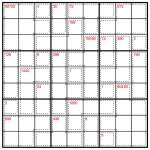
Killer Sudoku Multiplication 9×9 puzzle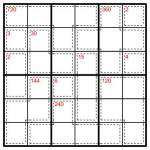
Killer Sudoku Multiplication 6×6 puzzle
I thought it would be interesting to see what a Killer Sudoku puzzle would look like if every operation in it was multiplication, so I decided to try it out.
The puzzles attached aren’t labelled with ‘x’ signs, but it should be fairly obvious from the totals that addition is not enough! Single-cell regions are simply equal to the stated value, but in all others you must multiply all of the cell values together to give the total at the top-left. Note that this follows Killer Sudoku rules, so a number cannot be repeated within a region.
These are all definitely rated ‘gentle’ – the logic required is simple, even though the multiplication might appear intimidating! In actual fact you don’t need to calculate most of the big values – try the 6×6 puzzle first to see why this is.
Good luck!
PS Subtraction and division are less interesting, unless you allow negative or fractional numbers! I’ll probably post examples of both the next couple of days anyway however!
Samurai Star Killer Sudoku
Apr 29th
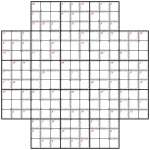
Samurai Star Killer (gentle) puzzle
“Star Killer” sounds like something out of science fiction, but it’s now definitely reality with this 5-grid Killer Sudoku puzzle. The actual Killer part uses the most basic logic imaginable, and there are a lot of ’singleton’ regions which I’ve never used in a Killer puzzle before. The reason for this is that I wanted to start at a gentle level – as a result this mostly solves like a regular Samurai Star (a.k.a. Flower Samurai) puzzle, with the Killer regions used occasionally to either get you going or help you out with a quick number along the way. It shouldn’t take you much over 20 or 30 minutes if you’ve solved this shape of Samurai before, and know what a Killer Sudoku is!
The rules are pretty simple: place 1 to 9 into each row, column and bold-lined 3×3 shape of each of the 5 underlying 9×9 grids (there’s one in the centre too), whilst also placing numbers so that the total in each dashed-line cage is equal to that given in the top-left corner. You may not repeat a number within a dashed-line cage.
The puzzle has rotation symmetry order 4, so the cages are in a pleasing pattern I hope – I particularly like the hole in the square in the centre! I think by and large that if you can create the cages or givens in a puzzle with the same order of symmetry that you have for the grid layout itself that this generally leads to a more pleasing appearance for the puzzle; but more than this, I find that this tends to follow through with the solving process, and you end up with pieces of the puzzle that feel ’sympathetic’ to one another, since the symmetry leads to related discoveries. However it’s perhaps not clear that this solving benefit carries through to a puzzle this large, and it’s probably the case that a puzzle with entirely random cages would feel just the same to actually solve at this size. But it wouldn’t look as nice!
Coming up in the following days I’m going to experiment in the space between Killer Sudoku and Ken Ken™ – in other words, using more operations than just addition, and possibly allowing repeated numbers in cages (although not on puzzles with 1-9 to place!). I already came across a puzzle called ‘Killer Sudoku Pro’ in the Saturday Telegraph newspaper (UK) – in this they keep the Killer Sudoku rules about not repeating digits in a cage, but specify different operations for cages (in actual fact the rules aren’t stated next to the puzzle in full, but I presume repeated digits are disallowed - it certainly solves okay with that assumption!). I haven’t seen anything precisely like that elsewhere and I thought it was actually quite fun (it wasn’t too hard!) so I’ll definitely try making some of those soon for sure. If you have any other ideas for how to mix these different types together feel free to post a comment!
Good luck!
Consecutive 5-grid Samurai Sudoku
Apr 24th
I thought it would be a nice idea to create a large Consecutive Sudoku for the weekend! And so here one is: a 5-grid Samurai Consecutive Sudoku. As you can see, there are very few givens to start with, so it will hopefully be at least a bit of a challenge! (It shouldn’t be as tricky as the Skyscraper version, at least once you get going!).
I’ve also decided to make Consecutive Sudoku the ‘puzzle of the month’ (”Masterclass”) puzzle in Sudoku Pro issue 45, which should be out in just under 2 months I think. Hopefully I’ll also make a book of them available online soon(ish!).
The rules for this Consecutive Samurai are simple: place 1 to 9 into each row, column and bold-lined 3×3 box of each of the 5 Sudoku grids, whilst also obeying the consecutive constraints – numbers with a white bar between are consecutive, whilst those without a white bar between are not consecutive. ”Consecutive” means that the difference between the values in the two squares is exactly 1: i.e. 1&2, 2&3, 3&4, 4&5, 5&6, 6&7, 7&8 or 8&9.
Good luck!
Shape Sudoku
Apr 23rd
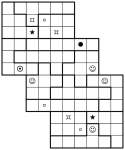
3-grid Shape Jigsaw Sudoku Samurai Stack
I needed to create one of these for a project elsewhere, so I thought I would post a couple of them here too – since I’d gone to the effort to make one at all! It’s not a new Sudoku variation, but just a very simple replacement of the digits 1 to 6 with shapes. None the less, it does make the puzzle notably harder to solve (or maybe that’s just me!). Unless there’s demand I won’t post this variant again, but I thought it would make an interesting change just for once!
I’ve created two examples – one is a simple 6×6 jigsaw, and the other is a 3-grid 6×6 Samurai Stack. In each case place one of each symbol into each 6-square row and column of each underlying 6×6 grid, and also one of each symbol into all of the bold-lined jigsaw shaped pieces.
Good luck!
5-grid Samurai Skyscraper
Apr 20th
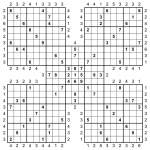
Samurai 5-grid Skyscraper puzzle
I thought I’d try one more Skyscraper Samurai Sudoku puzzle – this time a 5-grid variety, or what I think of as the ‘traditional’ Samurai Sudoku format (some people also call this Gattai-5, but I’ve not seen that in print anywhere).
The aim is to place 1 to 9 into each row, column and 3×3 bold-lined box of each of the 5 9×9 Sudoku grids, whilst also obeying the Skyscraper constraints. These tell you the number of digits that can be ’seen’ from the edge of the grid looking in along the adjacent row/column, where higher numbers obscure lower ones. Take a look at a couple of last week’s puzzles if you need more detailed instructions for this constraint.
As has been pointed out in the comments elsewhere, it doesn’t matter whether you consider that the Skyscraper clues apply to the nearest 9×9 grid or to the entire width/height of the row/column they attach to – once the first ‘9′ is reached then there are no higher numbers, and that’s guaranteed to happen within the first 9 squares.
I think this is probably about as large as you want to go with a relatively complex constraint such as Skyscraper, which is why I’ve included quite a few given numbers too – including some which clearly aren’t needed to give the puzzle a unique solution. (But please tell me if I’m wrong about this being big enough – I could always make a much larger one still just to prove that it’s possible!)
This week I plan to try out some other types of consecutive Sudoku variant – there are a couple of moderately-well-known types where you specify certain relationships between adjacent squares, such as ‘x2′ (where one number is twice the adjacent one – a bit like a slightly less-constrained version of consecutive sudoku!). If you have any ideas for other variants, feel free to let me know – I might try them out!
Good luck!
Consecutive Samurai Star
Apr 17th
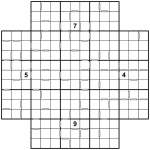
Samurai Star Consecutive puzzle
If the smaller consecutive puzzles weren’t enough of a challenge then this one should be! There are five overlaid 9×9 grids (including a ‘hidden’ one in the middle) which each need to have 1 to 9 placed into every row, column and bold-lined 3×3 box. On top of this you must obey the consecutive constraints – numbers with a white bar between are consecutive (12, 23, 34, 45, 56, 67, 78 or 89) and those without a bar between are not consecutive.
As you can see, the combination of tightly-overlaid grids and the consecutive marks means that very few givens are needed! Remember that none of these puzzles need ‘complex’ solving logic (you don’t need hidden or naked sets, X-wings or any other even more exotic strategy).
Good luck!
PS If there are any particular Sudoku or Samurai variants you’d like to see, please let me know and I’ll see what I can do!
Skyscraper Jigsaw Samurai Sudoku
Apr 16th
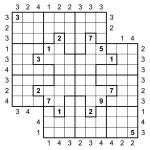
Skyscraper Jigsaw Samurai Sudoku puzzle
I’m pretty confident that you won’t have come across one of these puzzles before – I certainly haven’t! It’s a Samurai Skyscraper Sudoku puzzle with Jigsaw regions instead of regular 3×3 boxes.
The aim is to place 1 to 9 into each row and column of each of the two overlapping 9×9 grids, and also place 1 to 9 into each of the bold-lined jigsaw pieces. On top of that, you must also obey the Skyscraper constraints, which are the numbers outside the main puzzle grid. They specify the number of digits you can ’see’ from each point, where higher digits obscure lower digits (so a 7 obscures 1 to 6, and a 9 obscures all other digits, for example) – see yesterday’s post for a slightly longer explanation of how these constraints work.
Good luck!
Skyscraper Consecutive Sudoku
Apr 15th
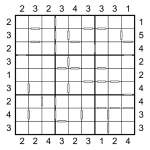
Skyscraper Consecutive Sudoku puzzle
Many of the best Sudoku variations can be combined with other variations in order to produce yet more types of puzzle. One variety I’ve personally never seen is to combine Skyscraper and Consecutive Sudoku together, so I thought I’d try it out today!
Skyscraper puzzles themselves are pleasant little puzzles where you must place 1 to 7 (or smaller) into each row and column of a grid whilst obeying ‘building height’ constraints around the edge. There’s an example 7×7 puzzle on this page over at puzzlemix. These building height constraints specify the number of notional buildings you could see whilst standing at the edge of the puzzle and looking in, whereby a taller building completely hides the view of any shorter building. The idea is that a digit ‘1′ in the grid is a building 1 storey high; a digit ‘2′ in the grid is a building 2 storeys high, and so on.
If you have a very simple 3×3 Skyscraper puzzle, here’s the potential solutions to each of the possible clues:
- 1: can be either 3 2 1 or 3 1 2, with the ‘3′ hiding both the other digits
- 2: can be 1 3 2 or 2 3 1 or 2 1 3.
- 3: can only be 1 2 3 because this is the only way to see all of the buildings.
I think that the maximum size of Skyscraper puzzle you can make without using any pre-solved numbers (givens) is 7×7, but by combining it with additional Sudoku constraints (i.e. the 3×3 boxes, and some given numbers in the puzzle already) you can make much larger puzzles.
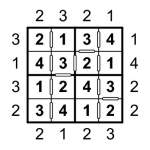
Example Consecutive Sudoku Skyscraper solution
So what we have here is a Skyscraper Sudoku – you must place 1 to 9 into each of the rows, columns and bold-lined 3×3 boxes whilst obeying the Skyscraper building height constraints around the edge of the puzzle. And then just to add an extra twist further to the puzzle, I’ve also included consecutive/non-consecutive constraints as in the previous days’ puzzles – click here for full instructions for these, but the basic idea is that a white bar separates two squares that have consecutive values (i.e. the mathematical difference is 1, so specifically 1&2, 2&3, 3&4, 4&5, 5&6, 6&7, 7&8 or 8&9) and if there’s no white bar then the difference is greater than 1 (i.e. they’re not consecutive).
I’ve attached an example 4×4 puzzle so you can be sure you understand how the Skyscraper (and consecutive) constraints work with this type of puzzle.
Good luck!
Consecutive Samurai Sudoku
Apr 14th
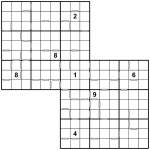
Consecutive 2-grid Samurai Sudoku
Well I promised a larger Consecutive Sudoku puzzle yesterday, and here one certainly is! It’s a 2-grid Consecutive Samurai Sudoku puzzle and the rules are essentially exactly the same as for yesterday’s puzzle except applied to a much larger grid.
The aim is to fit 1 to 9 into each of the rows, columns and 3×3 boxes of both of the two overlapping 9×9 puzzle grids, whilst obeying the consecutive constraints. In quick summary (read my full description yesterday), squares separated by a white bar contain values that are ‘consecutive’ – have a difference in value of exactly 1 – and those squares without a white bar between them are not consecutive – they have a difference in value greater than 1.
This puzzle is much trickier than my 6×6 example. It will probably take you half an hour or more to solve, of which by far the hardest part is working out how to start. Once you get going (which doesn’t require writing in ridiculous numbers of pencilmarks, I promise) it should keep flowing pretty smoothly.
If you need a hint then, the short version is this:
- You only have a few given numbers, so focus on areas around these – you don’t really need to worry about entirely empty parts of the grid far away from the givens to get going.
- Remember to solve both grids simultaneously and pay attention to the non-consecutive squares too!
- Focus on the centre 3×3 box – the information from both grids will help you make progress on it (and then from there you can actually consider both grids mostly independently)
A more detailed hint (but only a hint – not full instructions for getting going!) is this: after filling a few easy numbers around the ‘9′ in the bottom-right grid, the secret is to consider where a ‘9′ can go in the very centre box. Part of this deduction is remembering (and this is critical!) not just to pay attention to the consecutive squares but also the non-consecutive ones! Noting that the number directly below the ‘8′ in the centre 3×3 box of the top-left grid cannot possibly be a 7 or a 9 (and therefore the number to the right of that cannot be an 8, and the one to the right of that can’t be a 9) is a critical part of this process, along with a few deductions based around possible placements of 9s in the left three columns of the bottom-right 9×9 grid.
Good luck! (Once you get going this is a really fun puzzle!)
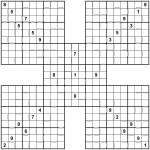
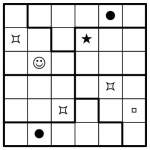

Recent Comments